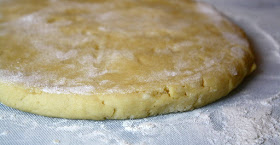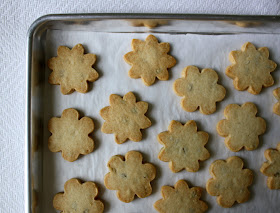"Life is like an onion: You peel it off one layer at a time, and sometimes you weep." -- Carl Sandburg (1878-1967)
This time of year, is there anything lovelier than a lustrous and golden Vidalia onion? The moist heft and smooth skin of the typical one-pounder naturally appeals to us. It's fresh and ripe in a way that most onions can only dream about. The way in which the Vidalias show up just once a year, have their coming-out party, and then, for the most part, quietly recede into the background endears us to them. They're similar to the New England cranberry crop in that respect--fragile in their brief longevity, and very distinctly American.
One could say that Vidalias didn't appear on the scene by design; they just happened. They were in fact a fluke, planted by a Depression-era Georgia farmer (Mr. Moses Coleman) who didn't get quite what he expected upon tasting his onion crop in 1931. Onions weren't supposed to be sweet! Who'd want a sweet onion? Indeed. Turned out everybody wanted a sweet onion. And they still do.
Personally, I tend to feel that Vidalias are the most cooperative member of the allium family (allium cepa vidalia, to be specific). They kindly refrain from burning my eyes when I slice them. Despite their rather forward juiciness, they shy away from causing discomfort. Most vegetables aren't that thoughtful. That fact alone sets the Vidalia apart from its less civilized and more barbaric cousins, as far as I'm concerned. How can you not love an onion that cares about your feelings? I mean, really.
Some folks even claim you can bite into one and munch it like an apple. Not sure I'm quite brave enough to try that just yet . . . but maybe one of these days I'll give it a go.
About this recipe . . .
One of my favorite pastry chefs, Nick Malgieri, has published at least two onion-tart recipes over the years that are very similar. This particular recipe, which he calls Swiss onion tart, is adapted from his book The Modern Baker; it is the less rich of the two I am familiar with (the other recipe, which calls for lard in the crust and higher quantities of eggs and cream, appears as Alsatian onion tart in an earlier book, A Baker's Tour).
Malgieri notes that he doesn't like to use onions that are sweet in this type of tart, but I have to disagree. I thought it was the perfect venue for beautiful sugary Vidalias. (This is blog is called Jane's Sweets, after all.) I reworded the instructions to reflect exactly what I did when I made these.
This satisfying little tart makes a nice main dish for a light lunch, alongside a spring-greens salad, and a thick wedge of melon. I can even see packing these tarts into a picnic basket.
Vidalia Onion Tart with Smoked Bacon
(For a printable version of this recipe, click here!)
Yield: Eight individual small tarts, or one large 10" - 12" tart
Ingredients for the tart dough:
1 and 1/2 cups all-purpose flour (I used unbleached.)
1/2 tsp. salt (I used sea salt.)
1 tsp. baking powder
10 Tbsp. unsalted butter, very cold, cut into chunks
1 large egg
1 large egg yolk
To make the tart dough:
In the large bowl of a food processor fitted with the metal blade, combine the flour, salt, and baking soda. Add into that the butter chunks, and pulse about 20 times until finely mixed.
Add in the egg and the egg yolk; pulse just until the dough begins to form into a ball.
Dump the dough out onto a lightly floured surface, gather it together, and press it into a round disk about 1/2" in thickness.
Cover the disk with plastic wrap and refrigerate it for one hour before rolling out.
Ingredients for the filling:
6 or 7 strips of thick cut smoked bacon, cooked until crisp (Be sure to make enough to equal 1/2 cup when fully cooked, well drained, and diced. Leave a very small amount of the bacon fat in the pan you used to cook the bacon; you'll use the same pan to cook the onions.)
3 Tbsp. butter, unsalted
1 and 1/2 lbs. Vidalia onions, peeled, halved, and sliced 1/4" thick
Salt (I used sea salt.)
1 Tbsp. all-purpose flour (I used unbleached.)
1/2 cup milk (I used 2 percent.)
1/2 heavy cream
Fresh ground black pepper
Fresh ground nutmeg (Don't use too much. Seriously.)
3 eggs, large
In the same pan that you used to make the bacon, melt the butter on medium heat. Add in all of the onions and generously salt them. When they begin to sizzle, lower the heat, and cover the pan. Cook for 20 minutes, stirring now and then; you want the onions to exude most of their water. Remove the lid, and continue to let the onions cook slowly for about 20 more minutes. They should be golden and quite reduced (aka caramelized!). When they're done, set them aside in the pan.
Preheat the oven to 350 degrees. Remove the dough from the fridge and cut it, pie style, into as many pieces as you'll need (eight equal sections for eight small tart pans, etc.), shaping each piece into a small disk. On a floured surface, using a floured rolling pin, roll each piece of dough out one at a time into a circle a little larger than your tart pan. Gently press the rolled piece down into the pan (best to use tart pans with removable bottoms) without stretching the dough.
Run the rolling pin right over the top; it will cut off the overhanging dough to give each tart a clean edge. Do this for all of your tarts. Put the tart shells onto a baking sheet.
In a large mixing bowl, place the 1 Tbsp. flour. Pouring slowly, whisk in the milk first, and then the cream. Stir in all of the cooked onions, excluding any extra drippings from the pan. Add salt, pepper, and a scant pinch of nutmeg to taste. Whisk the eggs in a small bowl with a fork, then add them in as well. Stir well to completely combine.
Portion the filling into each tart shell evenly (I used a small ladle to do this), making sure to put some onions into each one. Sprinkle bacon over the top of each tart.
Bake the tarts, on the baking sheet, for approximately 30 minutes, or until golden all over.
Let the tarts cool slightly before removing them carefully from their pans. Leftover tarts reheat well in the oven or microwave and can be refrigerated for a couple of days without losing their gusto.
 (If you'd like to comment on this post, or to read any existing comments, please click on the purple COMMENTS below!)
(If you'd like to comment on this post, or to read any existing comments, please click on the purple COMMENTS below!)




























































